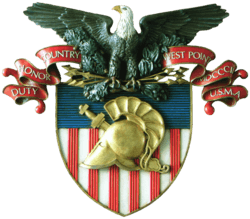Decius Wadsworth
Decius Wadsworth (January 2, 1768 Farmington, Connecticut – November 8, 1821 New Haven, Connecticut) was a Colonel in the U.S. Army before and during the War of 1812. He graduated from Yale University in 1785 with Honors. He was a renowned military organizer, engineer and inventor.
Family
Decius Wadsworth was born in 1768 in Farmington, Connecticut, the eldest son of William Wadsworth, III and Mercy Clarke. He was a scion of the prominent Wadsworth family of Connecticut. He was a sixth generation descendant of William Wadsworth, an original founder of Hartford, Connecticut. He was a contemporary and relative of Jeremiah Wadsworth, James Wadsworth, William Wadsworth, and James Wadsworth. Colonel Jeremiah Wadsworth, his second cousin, left Decius a handsome sum in his will in 1804. Decius never married.
Military career
In 1794, Decius Wadsworth was appointed by President George Washington as a captain in the Artillerist and Engineer Corps. He served was promoted to major in January 1800, and served as acting Superintendent of the Military Academy from 1803 until 1805, when he resigned. He returned to the army after being appointed Commissary General of Ordnance on July 2, 1812. On February 8, 1815, the Office of Commissary General of Ordnance was redesignated as the Chief of Ordnance. His department was charged with the procurement, supply, and maintenance of all cannon, small arms, powder, ball, shot, and other related items for the war effort. He drew up a set of regulations to ensure a system of uniformity in the armories and in the manufacture of ordnance material. He standardized small arms in the service and accomplished inventories of material at posts and forts around the country. Colonel Wadsworth served as the Chief of Ordnance until June 1, 1821, at which time he left the service due to illness.
Wadsworth's cipher
In 1817, he developed a cipher system based on a design by Thomas Jefferson, establishing a method that was continuously improved upon and used until the end of World War II.
Wadsworth's cipher system involved a set of two disks, one inside the other, where the outer disk had the 26 letters of the alphabet and the numbers 2–8, and the inner disk had only the 26 letters. The disks were geared at a ratio of 26:33. To encipher a message, the inner disk was turned until the desired letter was at the top position, with the number of turns required for the result transmitted as ciphertext. Due to the gearing, a ciphertext substitution for a character did not repeat until all 33 characters for the plaintext letter had been used. He received recognition for this method only posthumously.
References
- “Two Hundred and Fifty Years of the Wadsworth Family in America” by Horace Andrew Wadsworth, Eagle Steam Joe Printing, Boston, 1883
- "Historical Sketch of the Organization, Administration, Material and Tactics of the Artillery, United States Army", by William E. Birkheimer, Washington D.C., 1884
External links
| Military offices | ||
|---|---|---|
| Preceded by Jonathan Williams |
Superintendent of the U.S. Military Academy 1803–1805 (acting) |
Succeeded by Jonathan Williams |
